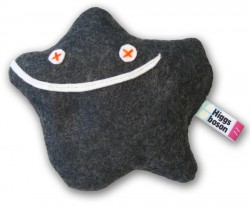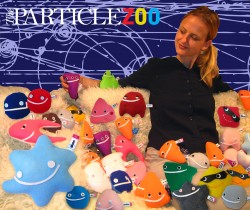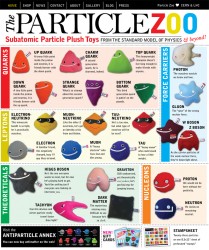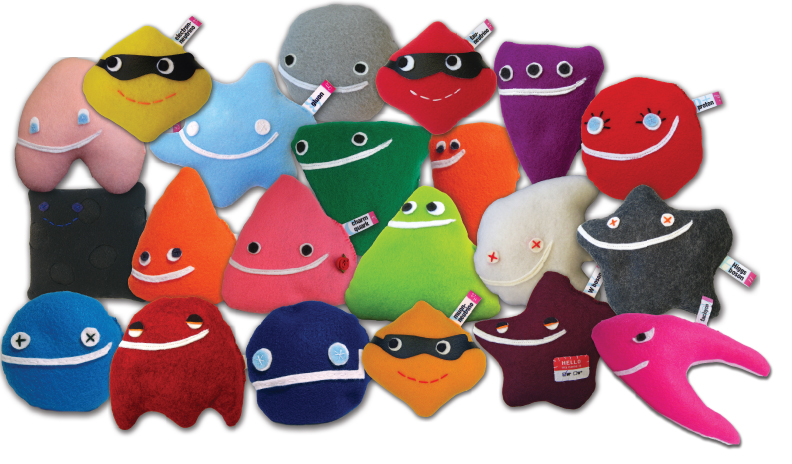[/caption]
This is a must for any particle physics enthusiast: collect your own particles in the form of a soft, cuddly plushie. From the theoretical Higgs boson to the well known electron, all the quantum particles from the Standard Model can be browsed and chosen for your personal collection. The Particle Zoo is the brain child of Los Angeles-based Julie Peasley, who is making it her duty to give our beloved particles a face and personality. For example: due to his popularity, the Higgs particle is a “bit of a snob” and therefore has a huge smile on his face (after all, wouldn’t you be really smug if everyone wanted to interview you?); the muon (or heavy electron) “lives fast and dies young“; or, hilariously, the unobserved graviton “has big legs for jumping branes.” All the particles have a story and a loving personality. Who would have thought quantum physics could be so much fun?

“If the particle toys can generate an interest in physics and the subatomic world, I’m grateful. At the very least now all my friends and family know what a boson is,” Julie responded when I asked about the educational uses for these cute creations. Teachers, professors and science educators have ordered whole sets of the particles for use in their physics lessons, proving that The Particle Zoo is not simply ‘just for fun.’
Identifying a face and personality for all the quarks, leptons, bosons, nucleons and theoreticals is not a task to be taken lightly, however. Every characteristic of the professionally-made particles must be likened to their real-world counterpart, thereby ensuring scientific accuracy. If the particle is heavy, it will be filled with something weighty, like gravel (check out the vital statistics for the Higgs boson for example); if it is massless, it is filled with light weight poly fill (such as the photon).
“The particles seem to be catching on more and more. I had a “special” on the Higgs particle all day on September 10 to celebrate the startup. I sold a record amount of particles in a short time. So I am now only $999,999,689 away from buying my own LHC.” – Particle Zookeeper Julie Peasley.


Although the LHC has suffered a technical hitch, and the first particle collisions aren’t expected to commence until spring 2009, The Particle Zoo will allow you to explore the quantum world for the time being. I for one have ordered my very own Higgs boson in preparation for my celebrations for when the first particles are collided by the LHC.
“I had a collection of the Giant Microbes toys and thought if people enjoyed those, maybe they would enjoy taking it a step further (well, to be honest, many orders of magnitude further). I honestly had no idea if anyone would be interested but I’m happy to say I’ve gotten over and beyond the positive response I could have imagined.” – Particle Zookeeper Julie Peasley.
So for now, any Higgs boson discovery will fall to Julie’s skilled hands in her “sweatshop of one” until the real force carrier is either proven or disproven in a few months time…
(Warning: Be sure not to leave any anti-particles mingling with the “normal” particles on the same shelf… the resulting annihilation may leave you swamped with fluffy photons…)
Source: Astroengine.com


:)))))
Outstandingly brilliant!
What is this good for? Children do not understand this or have a misconception of the real thing. Common people, same thing?Only scientists or science interested people might see the fun in this, but still: to spend $313 on the whole standard model of stuffed particle animals? Where do you put these, in your lab? Or in your bed?
I like the website and the design, but the commercial part is something I seem to miss completely. To mix this hard science with the mind of intertoys? But maybe I am to cynical.
Ooooo! Ooooo!
I wanna make a helium atom!
@Sharan:-
Teachers and lecturers alike have found uses for these toys to communicate the complex physics behind the quantum world. Granted, many people (including kids) won’t have a clue what a quark, neutrino or Higgs particle is, but isn’t that what education is all about? If particle physics can be taught through the medium of a small plushie, then great!
I know from experience that word/colour/character association works fantastically well when teaching a new concept. I already think of the Higgs boson as being a heavy, smug particle that’s tough to find. Nothing wrong with a bit of fun in the lecture theatre 😉
Cheers, Ian
FYI: Biologists are no stranger to all this, they already have “Giant Microbe” toys (http://www.giantmicrobes.com/). In university I saw countless numbers of the things in my dorms, they are still a massive hit. Why not scale down a bit and give subatomic particles a personality too?
Just a thought 😀
loved this….cheered up my day.
uh, don’t quarks come in three colors?
“Where do you put these, in your lab? Or in your bed? ”
Both! these are quantum particles who can be in two places at once.
This is sooo cool, but sad because I thought of this idea a little while ago. Oh well, it looks neat. I hope it lives long!
I wouldnt mind collecting the set
I hope that one of the members of the LHC will take one to show up at the tv and saying “we’ve seen Higgs Boson !!! :))))) science and fun work too.
ok ok :))
I’ll take one or 2 for my office anyway.
@Daren Scot Wilson: Three “colours” to add to your quarks.
http://www.particlezoo.net/individual_pages/shop_qcd.html